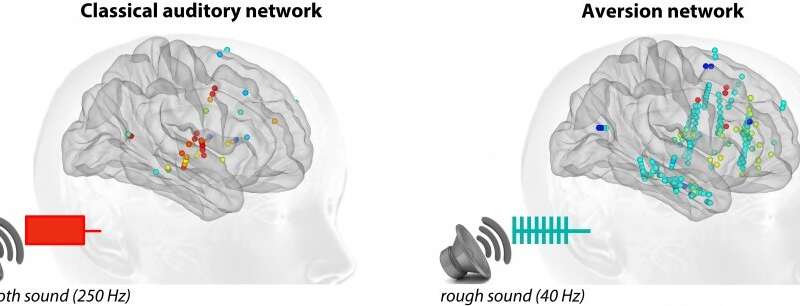Why is the brain disturbed by harsh sounds?

Why do the harsh sounds emitted by alarms or human shrieks grab our attention? What is going on in the brain when it detects these frequencies? Neuroscientists from the University of Geneva (UNIGE) and Geneva University Hospitals (HUG), Switzerland, have been analyzing how people react when they listen to a range of different sounds, the aim being to establish the extent to which repetitive sound frequencies are considered unpleasant. The scientists also studied the areas inside the brain that were stimulated when listening to these frequencies. Surprisingly, their results—which are published in Nature Communications—showed not only that the conventional sound-processing circuit is activated but also that the cortical and sub-cortical areas involved in the processing of salience and aversion are also solicited. This is a first, and it explains why the brain goes into a state of alert on hearing this type of sound.
Alarm sounds, whether artificial (such as a car horn) or natural (human screams), are characterized by repetitive sound fluctuations, which are usually situated in frequencies of between 40 and 80 Hz. But why were these frequencies selected to signal danger? And what happens in the brain to hold our attention to such an extent? Researchers from UNIGE and HUG played repetitive sounds of between 0 and 250 Hz to 16 participants closer and closer together in order to define the frequencies that the brain finds unbearable. “We then asked participants when they perceived the sounds as being rough (distinct from each other) and when they perceived them as smooth (forming one continuous and single sound),” explains Luc Arnal, a researcher in the Department of Basic Neurosciences in UNIGE’s Faculty of Medicine.
Based on the responses of participants, the scientists were able to establish that the upper limit of sound roughness is around 130 Hz. “Above this limit,” continues Arnal, “the frequencies are heard as forming only one continuous sound.” But why does the brain judge rough sounds to be unpleasant? In an attempt to answer this question, the neuroscientists asked participants to listen to different frequencies, which they had to classify on a scale of 1 to 5, 1 being bearable and 5 unbearable. “The sounds considered intolerable were mainly between 40 and 80 Hz, i.e. in the range of frequencies used by alarms and human screams, including those of a baby,” says Arnal. Since these sounds are perceptible from a distance, unlike a visual stimulus, it is crucial that attention can be captured from a survival perspective. “That’s why alarms use these rapid repetitive frequencies to maximize the chances that they are detected and gain our attention,” says the researcher. In fact, when the repetitions are spaced less than about 25 milliseconds apart, the brain cannot anticipate them and therefore suppress them. It is constantly on alert and attentive to the stimulus.
Harsh sounds fall outside the conventional auditory system
The researchers then attempted to find out what actually happens in the brain: why are these harsh sounds so unbearable? “We used an intracranial EEG, which records brain activity inside the brain itself in response to sounds,” explains Pierre Mégevand, a neurologist and researcher in the Department of Basic Neurosciences in the UNIGE Faculty of Medicine and at HUG.
When the sound is perceived as continuous (above 130 Hz), the auditory cortex in the upper temporal lobe is activated. “This is the conventional circuit for hearing,” says Mégevand. But when sounds are perceived as harsh (especially between 40 and 80 Hz), they induce a persistent response that additionally recruits a large number of cortical and sub-cortical regions that are not part of the conventional auditory system. “These sounds solicit the amygdala, hippocampus and insula in particular, all areas related to salience, aversion and pain. This explains why participants experienced them as being unbearable,” says Arnal, who was surprised to learn that these regions were involved in processing sounds.
Source: Read Full Article
